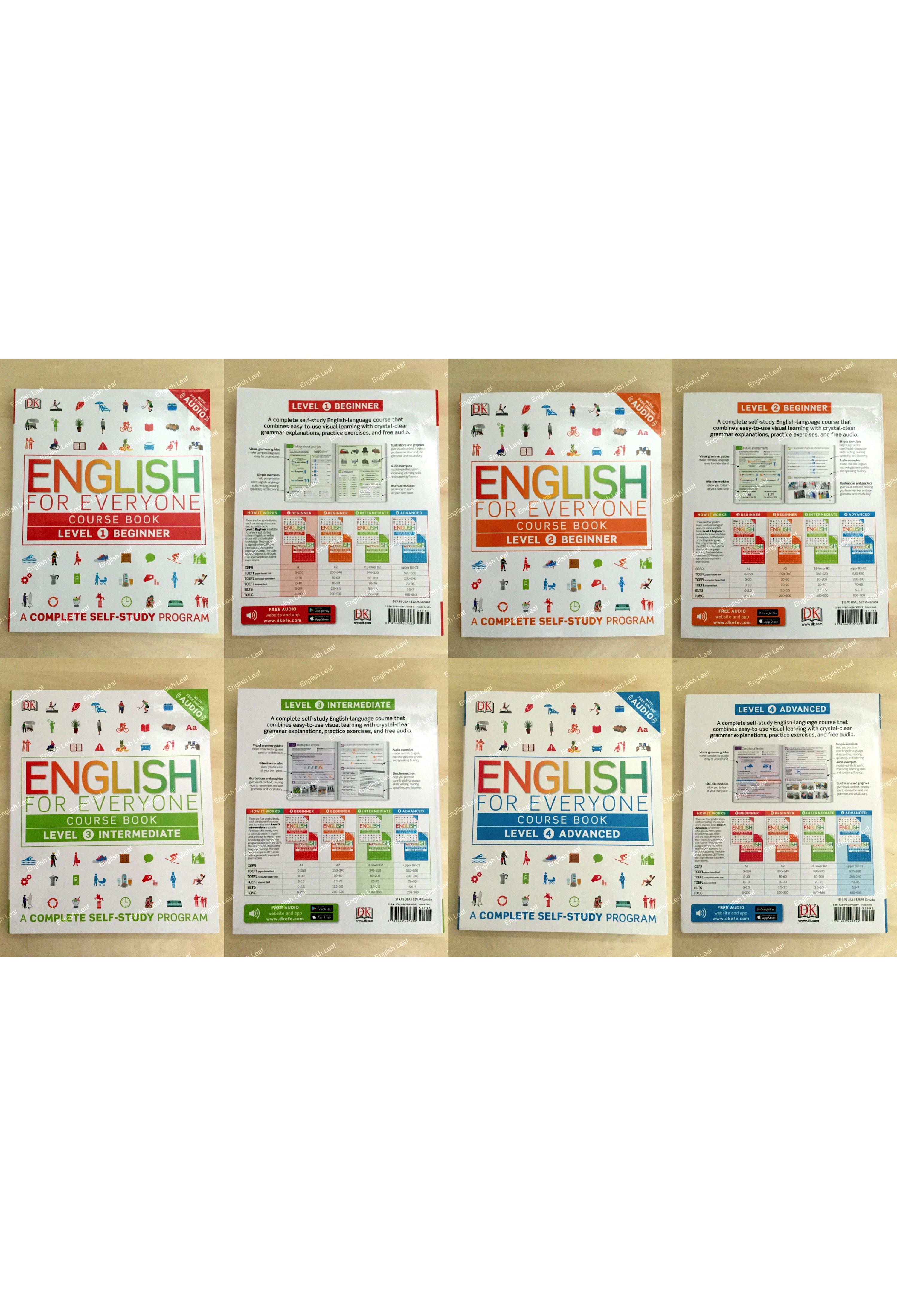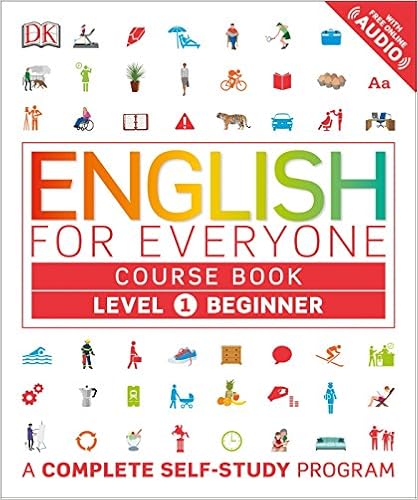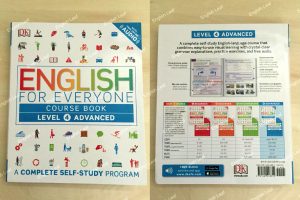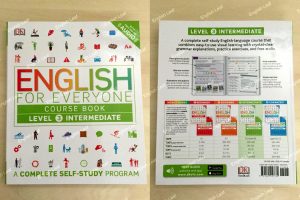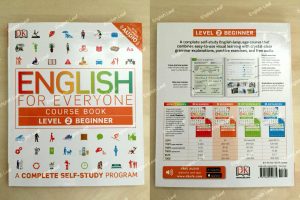英語で読む総合英語学習テキストの定番!
イギリスDK社刊行している”English for Everyone: Business English”。日本では洋書のテキストでのシリーズでもGrammar in Useなども有名ですが、こちらのEnglish for EveryoneでのCourse Bookでもレベル別で選ぶことができ、文法、ボキャブラリー、4技能の基礎とトータルな内容をカバーしている総合学習英語テキストとなっております。
【文法書のバイブル! English Grammar in Useシリーズの種類と選び方 – どれを選ぶ?】も確認する
English for Everyoneのレベル
Course Bookでのレベルは下記の様になっております。TOEICレベルでいうとLevel 2とLevel 3辺りが初めの一歩としておすすめで、Level 4はある程度の基礎ができている方向けになります。TOEICでいうと850点以上となります。
| Level 1: Beginner | Level 2: Beginner | Level 3: Intermediate | Level 4: Advanced | |
| CEFR | A1 | A2 | B1-lower B2 | upper B2-C1 |
| TOEFL paper-based test | 0~250 | 250~340 | 340~520 | 520~580 |
| TOEFL computer-based test | 0~30 | 30~60 | 60~200 | 200~240 |
| TOEFL internet test | 0~10 | 10~20 | 20~70 | 70~95 |
| IELTS | 0~2.5 | 2.5~3.5 | 3.5~5.5 | 5.5~7 |
| TOEIC | 0~200 | 200~500 | 500~850 | 850~900 |
目次 – English for Everyone: Level 1: Beginner, Course Book: A Complete Self-Study Program
様々な目的で使える
「English for Everyone」シリーズのレベル1です。TOEFL・TOEICなど主要の英語試験に必要な語彙や文法、演習がカバーされています。全ての内容が英語で書かれているため、最初から最後まで読むだけでも確実に英語力がアップします。
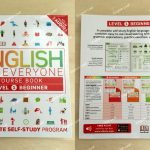
Author
Rachel Harding has a background in English-language teaching and is now a full-time author of English-language learning materials. She has written for major English-language publishers including Oxford University Press.
Course consultant
Tim Bowen has taught English and trained teachers in more than 30 countries worldwide. He is the co-author of works on pronunciation teaching and language-teaching methodology, and author of numerous books for English-language teachers. He is currently a freelance materials writer, editor, and translator. He is a member of the Chartered Institute of Linguists.
Language consultant
Professor Susan Barduhn is an experienced English-language teacher, teacher trainer, and author, who has contributed to numerous publications. In addition to directing English-language courses in at least four different continents, she has been President of the International Association of Teachers of English as a Foreign Language, and an adviser to the British Council and the US State Department. She is currently a Professor at the School for International Training in Vermont, USA.
Penguin Random House
US Editors Allison Singer, Jenny Siklos
Editors Gareth Clark, Lisa Gillespie, Andrew Kerr-Jarrett
Art Editors Chrissy Barnard, Ray Bryant
Senior Art Editor Sharon Spencer
Editorial Assistants Jessica Cawthra, Sarah Edwards
Illustrators Edwood Burn, Denise Joos, Michael Parkin, Jemma Westing
Audio Producer Liz Hammond
Managing Editor Daniel Mills
Managing Art Editor Anna Hall
Project Manager Christine Stroyan
Jacket Designer Natalie Godwin
Jacket Editor Claire Gell
Jacket Design Development Manager Sophia MTT
Producer, Pre-Production Luca Frassinetti
Producer Mary Slater
Publisher Andrew Macintyre
Art Director Karen Self
Publishing Director Jonathan Metcalf
DK India
Jacket Designer Surabhi Wadhwa
Managing Jackets Editor Saloni Singh
Senior DTP Designer Harish Aggarwal
First American Edition, 2016 Published in the United States by DK Publishing 1450 Broadway, Suite 801, New York, NY 10018
Copyright © 2016 Dorling Kindersley Limited DK, a Division of Penguin Random House LLC 109876 031-258528-Jun/2016
All rights reserved. Without limiting the rights under the copyright reserved above, no part of this publication may be reproduced, stored in or introduced into a retrieval system, or transmitted, in any form, or by any means (electronic, mechanical, photocopying, recording, or otherwise), without the prior written permission of the copyright owner. Published in Great Britain by Dorling Kindersley Limited.
A catalog record for this book is available from the Library of Congress. ISBN 978-1-4654-4762-3
DK books are available at special discounts when purchased in bulk for sales promotions, premiums, fund-raising, or educational use. For details, contact: DK Publishing Special Markets, 1450 Broadway, Suite 801, New York, NY 10018
Special Sales@dk.com
Printed and bound in the United States of America
All images © Dorling Kindersley Limited For further information see: www.dkimages.com
A WORLD OF IDEAS: SEE ALL THERE IS TO KNOW
www.dk.com
Contents
How the course works
01 Introducing yourself
New language Using “to be” with names
Vocabulary Names and letters
New skill Saying your name
02 Vocabulary Countries
03 Talking about yourself
New language “To be” with ages and nationalities
Vocabulary Numbers and nationalities
New skill Talking about yourself
04 Vocabulary Family and pets
05 Things you have
New language Possessive adjectives; “this” and “that”
Vocabulary Animals and family
New skill Talking about who things belong to
06 Using apostrophes
New language Possessive apostrophe
Vocabulary Family and pets
New skill Talking about belonging
07 Vocabulary Everyday things
08 Talking about your things
New language “These” and “those”
Vocabulary Possessions
New skill Using determiners and pronouns
09 Vocabulary Jobs
10 Talking about your job
New language Using “I am” for your job
Vocabulary Jobs and workplaces
New skill Describing your job
11 Telling the time
New language Times of day
Vocabulary Words for time
New skill Saying what the time is
12 Vocabulary Daily routines
13 Describing your day
New language The present simple
Vocabulary Routine activities
New skill Talking about your daily routine
14 Describing your week
New language Days and prepositions
Vocabulary Days of the week
New skill Talking about your weekly routine
15 Negatives with “to be”
New language Negatives with “to be”
Vocabulary “Not”
New skill Saying what things are not
16 More negatives
New language Present simple negative
Vocabulary Daily activities
New skill Saying what you don’t do
17 Simple questions
New language Simple questions
Vocabulary Jobs and routine activities
New skill Asking simple questions
18 Answering questions
New language Short answers
Vocabulary Jobs and routines
New skill Answering spoken questions
19 Asking questions
New language Open questions
Vocabulary Question words
New skill Asking for details
20 Vocabulary Around town
21 Talking about your town
New language “There is” and “there are”
Vocabulary Towns and buildings
New skill Describing a town
22 Using “a” and “the”
New language Definite and indefinite articles
Vocabulary Places in town
New skill Using articles
23 Orders and directions
New language Imperatives
Vocabulary Directions
New skill Finding your way
24 Joining sentences
New language Using “and” and “but”
Vocabulary Town, jobs, and family
New skill Joining sentences
25 Describing places
New language Adjectives
Vocabulary Place adjectives and nouns
New skill Describing places
26 Giving reasons
New language “Because”
Vocabulary Places and jobs
New skill Giving reasons
27 Vocabulary Around the house
28 The things I have
New language Using “have”
Vocabulary Household objects
New skill Talking about possessions
29 What do you have?
New language “Have” questions
Vocabulary House and furniture
New skill Asking about household objects
30 Vocabulary Food and drink
31 Counting
New language Uncountable nouns
Vocabulary Food containers
New skill Talking about food
32 Measuring
New language Measurements
Vocabulary Ingredients and quantities
New skill Talking about amounts
33 Vocabulary Clothes
34 At the shops
New language Using “too” and “fit”
Vocabulary Shopping and clothes
New skill Describing clothes
35 Describing things
New language Opinion adjectives
Vocabulary Shopping and materials
New skill Giving opinions
36 Vocabulary Sports
37 Talking about sports
New language “Go” and “play”
Vocabulary Sports
New skill Talking about sports
38 Vocabulary Hobbies and pastimes
39 Free time
New language Adverbs of frequency
Vocabulary Pastimes
New skill Talking about your free time
40 Likes and dislikes
New language “Love,” “like,” and “hate”
Vocabulary Food, sports, and pastimes
New skill Talking about what you like
41 Vocabulary Music
42 Expressing preference
New language Using “favorite”
Vocabulary Food and music
New skill Talking about your favorite things
43 Vocabulary Abilities
44 What you can and can’t do
New language “Can,” “can’t,” and “cannot”
Vocabulary Talents and abilities
New skill Saying what you can and can’t do
45 Describing actions
New language Regular and irregular adverbs
Vocabulary Hobbies and activities
New skill Describing activities
46 Describing ability
New language Modifying adverbs
Vocabulary Skills and abilities
New skill Saying how well you do things
47 Wishes and desires
New language “Would” and “want”
Vocabulary Leisure activities
New skill Talking about ambitions
48 Studying
New language Adverbs and articles
Vocabulary Academic subjects
New skill Talking about your studies
Answers
Index
How the course works
English for Everyone is designed for people who want to teach themselves the English language. Like all language courses, it covers the core skills: grammar, vocabulary, pronunciation, listening, speaking, reading, and writing. Unlike in other courses, the skills are taught and practiced as visually as possible, using images and graphics to help you understand and remember. The best way to learn is to work through the book in order, making full use of the audio available on the website and app. Turn to the practice book at the end of each unit to reinforce your learning with additional exercises.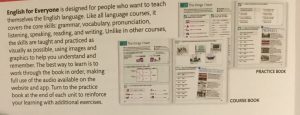
Unit number The book is divided into units. The unit number helps you keep track of your progress.
Learning points Every unit begins with a summary of the key learning points.
Modules Each unit is broken down into modules, which should be done in order. You can take a break from learning after completing any module.
Language learning Modules with colored backgrounds teach new vocabulary and grammar.
Study these carefully before moving on to the exercises.
Audio support Most modules have supporting audio recordings of native English speakers to help you improve your speaking and listening skills.
Exercises Modules with white backgrounds contain exercises that help you practice your new skills to reinforce learning.
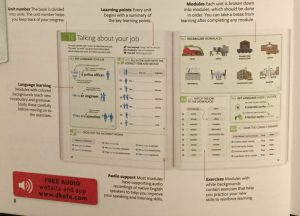
FREE AUDIO
website and app
www.dkefe.com
Language modules
New language points are taught in carefully graded stages, starting with a simple explanation of when they are used, then offering further examples of common usage and a detailed breakdown of how key constructions are formed.
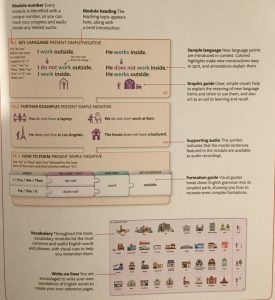
Module number Every module is identified with a unique number, so you can track your progress and easily locate any related audio.
Module heading The teaching topic appears here, along with a brief introduction.
Sample language New language points are introduced in context. Colored highlights make new constructions easy to spot, and annotations explain them.
Graphic guide Clear, simple visuals help to explain the meaning of new language forms and when to use them, and also act as an aid to learning and recall.
Supporting audio This symbol indicates that the model sentences featured in the module are available as audio recordings.
Formation guide Visual guides break down English grammar into its simplest parts, showing you how to recreate even complex formations.
Vocabulary Throughout the book, vocabulary modules list the most common and useful English words and phrases, with visual cues to help you remember them.
Write-on lines You are encouraged to write your own translations of English words to create your own reference pages.
Practice modules
Each exercise is carefully graded to drill and test the language taught in the corresponding course book units. Working through the exercises alongside the course book will help you remember what you have learned and become more fluent. Every exercise is introduced with a symbol to indicate which skill is being practiced.
GRAMMAR Apply new language rules in different contexts.
VOCABULARY Cement your understanding of key vocabulary.
SPEAKING Compare your spoken English to model audio recordings.
READING Examine target language in real-life English contexts.
LISTENING Test your understanding of spoken English
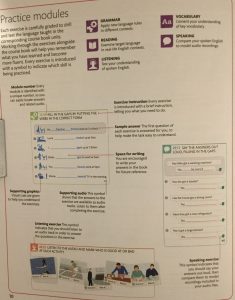
Module number Every module is identified with a unique number, so you can easily locate answers and related audio.
Exercise instruction Every exercise is introduced with a brief instruction, telling you what you need to do.
Sample answer the first question of each exercise is answered for you, to help make the task easy to understand.
Space for writing You are encouraged to write your answers in the book for future reference.
Supporting graphics Visual cues are given to help you understand the exercises.
Supporting audio This symbol shows that the answers to the exercise are available as audio tracks. Listen to them after completing the exercise.
Listening exercise This symbol indicates that you should listen to an audio track in order to answer the questions in the exercise.
Speaking exercise This symbol indicates that you should say your answers out loud, then compare them to model recordings included in your audio files.
Audio
English for Everyone features extensive supporting audio materials. You are encouraged to use them as much as you can, to improve your understanding of spoken English, and to make your own accent and pronunciation more natural. Each file can be played, paused, and repeated as often as you like, until you are confident you understand what has been said.
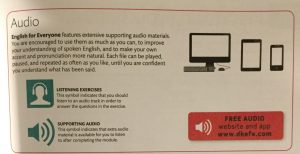
LISTENING EXERCISES This symbol indicates that you should listen to an audio track in order to answer the questions in the exercise.
SUPPORTING AUDIO This symbol indicates that extra audio material is available for you to listen to after completing the module.
FREE AUDIO website and app www.dkefe.com
Track your progress
The course is designed to make it easy to monitor your progress, with regular summary and review modules. Answers are provided for every exercise, so you can see how well you have understood each teaching point.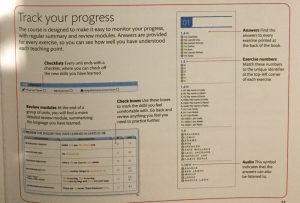
Checklists Every unit ends with a checklist, where you can check off the new skills you have learned.
Review modules At the end of a group of units, you will find a more detailed review module, summarizing the language you have learned.
Check boxes Use these boxes to mark the skills you feel comfortable with. Go back and review anything you feel you need to practice further.
Answers Find the answers to every exercise printed at the back of the book.
Exercise numbers Match these numbers to the unique identifier at the top-left corner of each exercise.
Audio This symbol indicates that the answers can also be listened to.
目次 – English for Everyone: Level 2: Beginner, Course Book: A Complete Self-Study Program
様々な目的で使える
「English for Everyone」シリーズのレベル2です。内容は、レベル1と同様に初心者向けで、TOEFL・TOEICなど主要の英語試験に必要な語彙や文法、演習がカバーされています。全ての内容が英語で書かれているため、最初から最後まで読むだけでも確実に英語力がアップします。
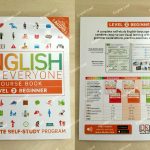
Author
Rachel Harding has a background in English-language teaching and is now a full-time author of English-language learning materials. She has written for major English-language publishers including Oxford University Press.
Course consultant
Tim Bowen has taught English and trained teachers in more than 30 countries worldwide. He is the co-author of works on pronunciation teaching and language-teaching methodology, and author of numerous books for English-language teachers. He is currently a freelance materials writer, editor, and translator. He is a member of the Chartered Institute of Linguists.
Language consultant
Professor Susan Barduhn is an experienced English-language teacher, teacher trainer, and author, who has contributed to numerous publications. In addition to directing English-language courses in at least four different continents, she has been President of the International Association of Teachers of English as a Foreign Language, and an adviser to the British Council and the US State Department. She is currently a Professor at the School for International Training in Vermont, USA.
Penguin Random House
US Editors Allison Singer, Jenny Siklos
Editors Gareth Clark, Lisa Gillespie, Andrew Kerr-Jarrett
Art Editors Chrissy Barnard, Ray Bryant
Senior Art Editor Sharon Spencer
Editorial Assistants Jessica Cawthra, Sarah Edwards
Illustrators Edwood Burn, Denise Joos, Michael Parkin, Jemma Westing
Audio Producer Liz Hammond
Managing Editor Daniel Mills
Managing Art Editor Anna Hall
Project Manager Christine Stroyan
Jacket Designer Natalie Godwin
Jacket Editor Claire Gell
Jacket Design Development Manager Sophia MTT
Producer, Pre-Production Luca Frassinetti
Producer Mary Slater
Publisher Andrew Macintyre
Art Director Karen Self
Publishing Director Jonathan Metcalf
DK India
Jacket Designer Surabhi Wadhwa
Managing Jackets Editor Saloni Singh
Senior DTP Designer Harish Aggarwal
First American Edition, 2016 Published in the United States by DK Publishing 1450 Broadway, Suite 801, New York, NY 10018, USA
Copyright © 2016 Dorling Kindersley Limited DK, a Division of Penguin Random House LLC 1920109876 027-292811-Jun/2016
All rights reserved. Without limiting the rights under the copyright reserved above, no part of this publication may be reproduced, stored in or introduced into a retrieval system, or transmitted, in any form, or by any means (electronic, mechanical, photocopying, recording, or otherwise), without the prior written permission of the copyright owner. Published in Great Britain by Dorling Kindersley Limited.
A catalog record for this book is available from the Library of Congress. ISBN 978-1-4654-5183-5
DK books are available at special discounts when purchased in bulk for sales promotions, premiums, fund-raising, or educational use. For details, contact: DK Publishing Special Markets, 1450 Broadway, Suite 801, New York, NY 10018, USA
Special Sales@dk.com
Printed and bound in Canada
All images © Dorling Kindersley Limited For further information see: www.dkimages.com
A WORLD OF IDEAS: SEE ALL THERE IS TO KNOW
www.dk.com
Contents
How the course works
01 Talking about yourself
New language Using “to be”
Vocabulary Names, jobs, and family
New skill Talking about yourself
02 Talking about routines
New language The present simple
Vocabulary Routines and pastimes
New skill Talking about routines
03 Today I’m wearing…
New language The present continuous
Vocabulary Clothes and activities
New skill Talking about what’s happening now
04 What’s happening?
New language Present continuous questions
Vocabulary Activities and gadgets
New skill Asking about the present
05 Types of verbs
New language Action and state verbs
Vocabulary Activities
New skill Using state verbs
06 Vocabulary Feelings and moods
07 How are you feeling?
New language “Feeling” and emotions
Vocabulary Adjectives of emotions
New skill Talking about your feelings
08 Vocabulary Transportation
09 Routines and exceptions
New language Exceptions
Vocabulary Time markers
New skill Contrasting routines and exceptions
10 Vocabulary The body
11 What’s the matter?
New language Health complaints
Vocabulary Body parts and pain phrases
New skill Saying what’s wrong
12 Vocabulary Weather
13 What’s the weather like?
New language Weather descriptions
Vocabulary Temperature words
New skill Talking about the weather
14 Vocabulary Travel
15 Making comparisons
New language Comparative adjectives
Vocabulary Travel and countries
New skill Comparing things
16 Talking about extremes
New language Superlative adjectives
Vocabulary Animals, facts, and places
New skill Talking about extremes
17 Vocabulary Geographical features
18 Making choices
New language “Which” and “what”
Vocabulary Geographical words
New skill Asking multiple-choice questions
19 Using large numbers
New language Large numbers
Vocabulary Thousands and millions
New skill Talking about large amounts
20 Vocabulary The calendar
21 Talking about dates
New language Dates, “was born”, “ago”
Vocabulary Numbers, months, and years
New skill Talking about dates
22 Talking about the past
New language The past simple of “to be”
Vocabulary Jobs, town, and life events
New skill Talking about past states
23 Past events
New language Regular verbs in the past simple
Vocabulary Pastimes and life events
New skill Talking about your past
24 Past abilities
New language Using “could” in the past simple
Vocabulary Abilities and pastimes
New skill Talking about past abilities
25 Vocabulary Entertainment
26 Irregular past verbs
New language Irregular verbs in the past simple
Vocabulary Sequence words
New skill Describing the past
27 Vocabulary Tools and implements
28 Telling a story
New language “About” opinions
Vocabulary Opinions
New skill Describing media and culture
29 Asking about the past
New language Past simple questions
Vocabulary Travel and activities
New skill Talking about vacations
30 Applying for a job
New language Interview responses
Vocabulary Job words and phrases
New skill Dealing with job applications
31 Types of questions
New language Subject and object questions
Vocabulary Workplace words
New skill Asking different kinds of question
32 Someone, anyone, everyone
New language Indefinite pronouns
Vocabulary Office words
New skill Talking about people in general
33 Making conversation
New language Short questions
Vocabulary Question words
New skill Asking short questions
34 Vocabulary Going out
35 Future arrangements
New language Future with present continuous
Vocabulary Excuses
New skill Talking about future arrangements
36 Plans and intentions
New language Future tense
Vocabulary Time words and phrases
New skill Talking about your plans
37 What’s going to happen
New language The future with “going to”
Vocabulary Prediction verbs
New skill Predicting future events
38 Vocabulary Animals
39 Making predictions
New language The future with “will”
Vocabulary Prediction words
New skill Saying what you think will happen
40 Making quick decisions
New language Quick decisions with “will”
Vocabulary Decision words
New skill Talking about future actions
41 Future possibilities
New language Using “might”
Vocabulary Activities, food, and pastimes
New skill Talking about future possibilities
42 Giving advice
New language “Should”
Vocabulary Advice
New skill Giving advice
43 Making suggestions
New language “Could” for suggestions
Vocabulary Advice
New skill Making suggestions
44 Vocabulary Household chores
45 Around the house
New language The present perfect
Vocabulary Household chores
New skill Talking about the recent past
46 Events in your life
New language The present perfect
Vocabulary Adventure sports
New skill Talking about past events
47 Events in your year
New language “Yet” and “already”
Vocabulary Routines and chores
New skill Talking about the recent past
48 Eating out
New language Restaurant phrases
Vocabulary Food preparation
New skill Ordering a meal in a restaurant
49 Achievements and ambitions
New language Desires and plans
Vocabulary Travel and adventure sports
New skill Talking about your achievements
Answers
Index
How the course works
English for Everyone is designed for people who want to teach themselves the English language. Like all language courses, it covers the core skills: grammar, vocabulary, pronunciation, listening, speaking, reading, and writing. Unlike in other courses, the skills are taught and practiced as visually as possible, using images and graphics to help you understand and remember. The best way to learn is to work through the book in order, making full use of the audio available on the website and app. Turn to the practice book at the end of each unit to reinforce your learning with additional exercises.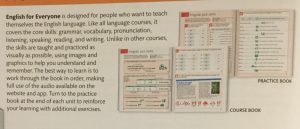
Unit number The book is divided into units. The unit number helps you keep track of your progress.
Learning points Every unit begins with a summary of the key learning points.
Modules Each unit is broken down into modules, which should be done in order. You can take a break from learning after completing any module.
Language learning Modules with colored backgrounds teach new vocabulary and grammar.
Study these carefully before moving on to the exercises.
Audio support Most modules have supporting audio recordings of native English speakers to help you improve your speaking and listening skills.
Exercises Modules with white backgrounds contain exercises that help you practice your new skills to reinforce learning.
FREE AUDIO
website and app
www.dkefe.com
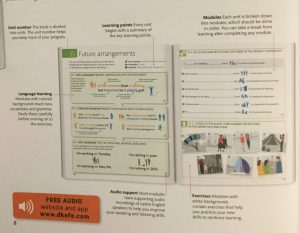
Language modules
New language points are taught in carefully graded stages, starting with a simple explanation of when they are used, then offering further examples of common usage and a detailed breakdown of how key constructions are formed.

Module number Every module is identified with a unique number, so you can track your progress and easily locate any related audio.
Module heading The teaching topic appears here, along with a brief introduction.
Sample language New language points are introduced in context. Colored highlights make new constructions easy to spot, and annotations explain them.
Graphic guide Clear, simple visuals help to explain the meaning of new language forms and when to use them, and also act as an aid to learning and recall.
Supporting audio This symbol indicates that the model sentences featured in the module are available as audio recordings.
Formation guide Visual guides break down English grammar into its simplest parts, showing you how to recreate even complex formations.
Vocabulary Throughout the book, vocabulary modules list the most common and useful English words and phrases, with visual cues to help you remember them.
Write-on lines You are encouraged to write your own translations of English words to create your own reference pages.
Practice modules
Each exercise is carefully graded to drill and test the language taught in the corresponding course book units. Working through the exercises alongside the course book will help you remember what you have learned and become more fluent. Every exercise is introduced with a symbol to indicate which skill is being practiced.
GRAMMAR Apply new language rules in different contexts.
VOCABULARY Cement your understanding of key vocabulary.
SPEAKING Compare your spoken English to model audio recordings.
READING Examine target language in real-life English contexts.
LISTENING Test your understanding of spoken English
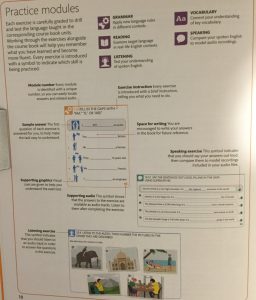
Module number Every module is identified with a unique number, so you can easily locate answers and related audio.
Exercise instruction Every exercise is introduced with a brief instruction, telling you what you need to do.
Sample answer the first question of each exercise is answered for you, to help make the task easy to understand.
Space for writing You are encouraged to write your answers in the book for future reference.
Supporting graphics Visual cues are given to help you understand the exercises.
Supporting audio This symbol shows that the answers to the exercise are available as audio tracks. Listen to them after completing the exercise.
Listening exercise This symbol indicates that you should listen to an audio track in order to answer the questions in the exercise.
Speaking exercise This symbol indicates that you should say your answers out loud, then compare them to model recordings included in your audio files.
Audio
English for Everyone features extensive supporting audio materials. You are encouraged to use them as much as you can, to improve your understanding of spoken English, and to make your own accent and pronunciation more natural. Each file can be played, paused, and repeated as often as you like, until you are confident you understand what has been said.
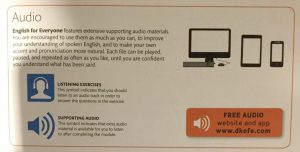
LISTENING EXERCISES This symbol indicates that you should listen to an audio track in order to answer the questions in the exercise.
SUPPORTING AUDIO This symbol indicates that extra audio material is available for you to listen to after completing the module.
FREE AUDIO website and app www.dkefe.com
Track your progress
The course is designed to make it easy to monitor your progress, with regular summary and review modules. Answers are provided for every exercise, so you can see how well you have understood each teaching point.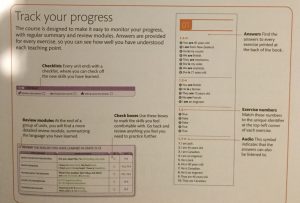
Checklists Every unit ends with a checklist, where you can check off the new skills you have learned.
Review modules At the end of a group of units, you will find a more detailed review module, summarizing the language you have learned.
Check boxes Use these boxes to mark the skills you feel comfortable with. Go back and review anything you feel you need to practice further.
Answers Find the answers to every exercise printed at the back of the book.
Exercise numbers Match these numbers to the unique identifier at the top-left corner of each exercise.
Audio This symbol indicates that the answers can also be listened to.
目次 – English for Everyone: Level 3: Intermediate, Course Book: A Complete Self-Study Program
英語は英語で学ぶ
「English for Level」シリーズのレベル3です。レベル1,2とは異なり、中級者向けです。TOEFL・TOEICなど主要の英語試験に必要な語彙や文法、演習がカバーされています。本書の文章は全て英語で書かれており、英語を英語で学ぶことによって新しい気づきを得られます。

Author
Gill Johnson is an experienced English-language teacher, author, teacher-trainer, and conference speaker. She currently runs a large modern languages department at an international school in Sussex, UK, and spends her holidays training teachers worldwide.
Course consultant
Tim Bowen has taught English and trained teachers in more than 30 countries worldwide. He is the co-author of works on pronunciation teaching and language-teaching methodology, and author of numerous books for English-language teachers. He is currently a freelance materials writer, editor, and translator. He is a member of the Chartered Institute of Linguists.
Language consultant
Professor Susan Barduhn is an experienced English-language teacher, teacher trainer, and author, who has contributed to numerous publications. In addition to directing English-language courses in at least four different continents, she has been President of the International Association of Teachers of English as a Foreign Language, and an adviser to the British Council and the US State Department. She is currently a Professor at the School for International Training in Vermont, USA.
Penguin Random House
US Editors Allison Singer, Jenny Siklos
Editors Gareth Clark, Lisa Gillespie, Andrew Kerr-Jarrett
Art Editors Chrissy Barnard, Ray Bryant
Senior Art Editor Sharon Spencer
Editorial Assistants Jessica Cawthra, Sarah Edwards
Illustrators Edwood Burn, Denise Joos, Michael Parkin, Jemma Westing
Audio Producer Liz Hammond
Managing Editor Daniel Mills
Managing Art Editor Anna Hall
Project Manager Christine Stroyan
Jacket Designer Natalie Godwin
Jacket Editor Claire Gell
Jacket Design Development Manager Sophia MTT
Producer, Pre-Production Luca Frassinetti
Producer Mary Slater
Publisher Andrew Macintyre
Art Director Karen Self
Publishing Director Jonathan Metcalf
DK India
Jacket Designer Surabhi Wadhwa
Managing Jackets Editor Saloni Singh
Senior DTP Designer Harish Aggarwal
First American Edition, 2016 Published in the United States by DK Publishing 1450 Broadway, Suite 801, New York, NY 10018
Copyright © 2016 Dorling Kindersley Limited DK, a Division of Penguin Random House LLC 191098 026-284202-Jun/2016
All rights reserved. Without limiting the rights under the copyright reserved above, no part of this publication may be reproduced, stored in or introduced into a retrieval system, or transmitted, in any form, or by any means (electronic, mechanical, photocopying, recording, or otherwise), without the prior written permission of the copyright owner. Published in Great Britain by Dorling Kindersley Limited.
A catalog record for this book is available from the Library of Congress. ISBN 978-1-4654-4763-0
DK books are available at special discounts when purchased in bulk for sales promotions, premiums, fund-raising, or educational use. For details, contact: DK Publishing Special Markets, 1450 Broadway, Suite 801, New York, NY 10018
Special Sales@dk.com
Printed and bound in China
All images © Dorling Kindersley Limited For further information see: www.dkimages.com
A WORLD OF IDEAS: SEE ALL THERE IS TO KNOW
www.dk.com
Contents
How the course works
01 Making conversation
New language Question tags
Vocabulary Introductions and greetings
New skill Making conversation
02 Vocabulary Countries
03 Where things are
New language Prepositions of place
Vocabulary Countries and nationalities
New skill Talking about where things are
04 Numbers and statistics
New language Numbers in spoken English
Vocabulary Sports events
New skill Using numbers in conversation
05 Times and dates
New language Precise times
Vocabulary Dates in US and UK English
New skill Talking about times and dates
06 Contact details
New language Letters and numbers
Vocabulary Contact details
New skill Exchanging personal information
07 Talking about jobs
New language “Job” and “work”
Vocabulary Jobs and professions
New skill Talking about your career
08 Routine and free time
New language Adverbs of frequency
Vocabulary Leisure activities
New skill Talking about routines
09 Everyday activities
New language Phrasal verbs
Vocabulary Work and leisure
New skill Talking about everyday activities
10 Vocabulary Body and appearance
11 Describing people
New language Adjective order
Vocabulary Adjectives for describing people
New skill Describing people in detail
12 Vocabulary Clothes and accessories
13 What I’m wearing
New language The present continuous
Vocabulary Clothes and fashion
New skill Describing clothes
14 Vocabulary Rooms and furniture
15 Daily routines
New language Collocations
Vocabulary Routines and chores
New skill Talking about your day
16 Separable phrasal verbs
New language Separable phrasal verbs
Vocabulary Around town
New skill Describing a town in detail
17 Comparing places
New language Modifiers
Vocabulary Geographical terms
New skill Describing and comparing places
18 Likes and dislikes
New language Adjectives with “-ing” and “-ed”
Vocabulary Feelings and emotions
New skill Talking about likes and dislikes
19 Vocabulary Family and growing up
20 Early years
New language “Did” for emphasis
Vocabulary Baby equipment and parenting
New skill Describing your childhood
21 Vocabulary Education
22 Changing meaning
New language Prefixes and suffixes
Vocabulary Studying
New Skill Changing the meaning of words
23 Vocabulary Transportation and travel
24 Places I have been
New language Present perfect tense
Vocabulary Travel experiences
New skill Talking about the recent past
25 Things I have done
New language Modifying adverbs
Vocabulary Adventure sports
New skill Talking about your achievements
26 Activities in progress
New language Present perfect continuous
Vocabulary Home improvements
New skill Talking about activities in the past
27 My talents and skills
New language Present perfect continuous questions
Vocabulary Hobbies and interests
New skill Asking about past events
28 Activities and their results
New language Forms of the present perfect
Vocabulary State and action verbs
New skill Talking about results of activities
29 Everyday problems
New language Negative prefixes
Vocabulary Urban problems
New skill Talking about everyday problems
30 General and specific things
New language Definite and zero articles
Vocabulary Possessions
New skill Talking about the things you own
31 Vocabulary Food and drink
32 Myself, yourself
New language Reflexive pronouns
Vocabulary Measurements and flavors
New skill Talking about food and recipes
33 What things are for
New language Gerunds and infinitives
Vocabulary Household gadgets
New skill Talking about why you use things
34 Vocabulary Sports
35 Opinions and plans
New language Simple verb patterns
Vocabulary Sports and leisure
New skill Talking about opinions and plans
36 Future arrangements
New language Present continuous for plans
Vocabulary Collocations with “take”
New skill Talking about future arrangements
37 Planning the future
New language “Going to”
Vocabulary Healthy living
New skill Talking about plans to keep fit
38 Vocabulary Weather and climate
39 Predictions and promises
New language Future tense with “will”
Vocabulary Weather
New skill Making predictions and promises
40 Possibility
New language “Might” to show possibility
Vocabulary Weather and landscape
New skill Discussing possibilities
41 Vocabulary Sickness and health
42 Obligations
New language “Must” and “have to”
Vocabulary Health and sickness
New skill Expressing obligation
43 Making deductions
New language “Might” and “could”
Vocabulary Health and sickness
New skill Talking about possibility
44 Polite requests
New language “Can,” “could,” and “may”
Vocabulary Good manners
New skill Asking for permission
45 More phrasal verbs
New language Three-word phrasal verbs
Vocabulary Personal relationships
New skill Understanding informal English
46 Asking for agreement
New language Question tags
Vocabulary Travel and leisure plans
New skill Checking information
47 Vocabulary Science and tools
48 Things that are always true
New language Zero conditional
Vocabulary Scientific facts
New skill Talking about general truths
49 Describing a process
New language Present simple passive
Vocabulary Science experiments
New skill Describing a process
50 Things that might happen
New language First conditional
Vocabulary Tools and making things
New skill Giving advice and instructions
51 Solving problems
New language First conditional with imperative
Vocabulary Health and wellbeing
New skill Giving advice and instructions
52 Planning activities
New language Subordinate time clauses
Vocabulary Building works
New skill Describing sequences of events
53 Unlikely situations
New language Second conditional
Vocabulary Collocations with “make” and “do”
New skill Talking about future dreams
54 Vocabulary Emotions
55 Giving advice
New language “If I were you”
Vocabulary Phrases for giving advice
New skill Making suggestions
56 Real and unreal situations
New language First and second conditional
Vocabulary Collocations for business meetings
New skill Talking about possibilities
57 Being specific
New language Defining relative clauses
Vocabulary Personal characteristics
New skill Describing people and jobs
58 Adding information
New language Non-defining relative clauses
Vocabulary Personal characteristics
New skill Describing people, places, and things
59 What was happening when?
New language Past continuous
Vocabulary Verb/ noun collocations
New skill Talking about events at given times
60 Vocabulary The natural world
61 Setting the scene
New language Past continuous
Vocabulary Adjectives to describe places
New skill Setting the scene for a story
62 Interrupted actions
New language Past continuous and past simple
Vocabulary Travel and leisure
New skill Describing interrupted actions
63 Events in the past
New language Past simple passive
Vocabulary Environmental disasters
New skill Talking about important events
64 Before and after
New language Past perfect and past simple
Vocabulary Visual arts
New skill Describing sequences of past events
65 First times
New language “Never” / “ever” with past tenses
Vocabulary Travel adjectives
New skill Describing new experiences
66 Vocabulary Common English idioms
67 Telling a story
New language Narrative tenses
Vocabulary Idioms for storytelling
New skill Using different past tenses
68 What happened when?
New language Time adverbs and phrases
Vocabulary Storytelling devices
New skill Putting events in order
69 What other people said
New language Reported speech
Vocabulary Work and education
New skill Talking about people’s lives
70 Telling things to people
New language Reported speech with “tell”
Vocabulary Collocations with “say” and “tell”
New skill Talking about truth and lies
71 Suggestions and explanations
New language Reporting verbs with “that”
Vocabulary More reporting verbs
New skill Reporting explanations
72 Telling people what to do
New language Verbs with object and infinitive
Vocabulary Reporting verbs
New skill Reporting advice and instructions
73 What other people asked
New language Reported questions
Vocabulary Collocations with “raise”
New skill Reporting direct questions
74 Reporting simple questions
New language “f” and “whether”
Vocabulary Verb/ preposition collocations
New skill Reporting simple questions
75 Polite questions
New language Indirect questions
Vocabulary Practical issues
New skill Asking polite questions
76 Wishes and regrets
New language “Wish” with past tenses
Vocabulary Life events
New skill Talking about regrets
Answers
Index
How the course works
English for Everyone is designed for people who want to teach themselves the English language. Like all language courses, it covers the core skills: grammar, vocabulary, pronunciation, listening, speaking, reading, and writing. Unlike in other courses, the skills are taught and practiced as visually as possible, using images and graphics to help you understand and remember. The best way to learn is to work through the book in order, making full use of the audio available on the website and app. Turn to the practice book at the end of each unit to reinforce your learning with additional exercises.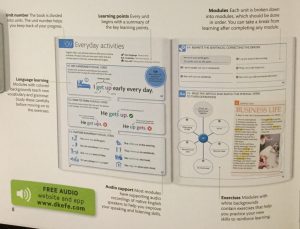
Unit number The book is divided into units. The unit number helps you keep track of your progress.
Learning points Every unit begins with a summary of the key learning points.
Modules Each unit is broken down into modules, which should be done in order. You can take a break from learning after completing any module.
Language learning Modules with colored backgrounds teach new vocabulary and grammar.
Study these carefully before moving on to the exercises.
Audio support Most modules have supporting audio recordings of native English speakers to help you improve your speaking and listening skills.
Exercises Modules with white backgrounds contain exercises that help you practice your new skills to reinforce learning.
FREE AUDIO
website and app
www.dkefe.com
Language modules
New language points are taught in carefully graded stages, starting with a simple explanation of when they are used, then offering further examples of common usage and a detailed breakdown of how key constructions are formed.
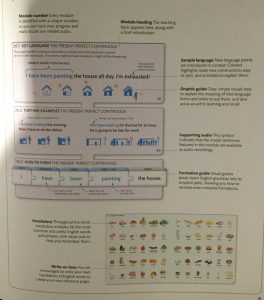
Module number Every module is identified with a unique number, so you can track your progress and easily locate any related audio.
Module heading The teaching topic appears here, along with a brief introduction.
Sample language New language points are introduced in context. Colored highlights make new constructions easy to spot, and annotations explain them.
Graphic guide Clear, simple visuals help to explain the meaning of new language forms and when to use them, and also act as an aid to learning and recall.
Supporting audio This symbol indicates that the model sentences featured in the module are available as audio recordings.
Formation guide Visual guides break down English grammar into its simplest parts, showing you how to recreate even complex formations.
Vocabulary Throughout the book, vocabulary modules list the most common and useful English words and phrases, with visual cues to help you remember them.
Write-on lines You are encouraged to write your own translations of English words to create your own reference pages.
Practice modules
Each exercise is carefully graded to drill and test the language taught in the corresponding course book units. Working through the exercises alongside the course book will help you remember what you have learned and become more fluent. Every exercise is introduced with a symbol to indicate which skill is being practiced.
GRAMMAR Apply new language rules in different contexts.
VOCABULARY Cement your understanding of key vocabulary.
SPEAKING Compare your spoken English to model audio recordings.
READING Examine target language in real-life English contexts.
LISTENING Test your understanding of spoken English
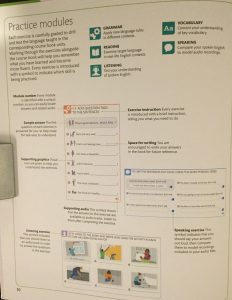
Module number Every module is identified with a unique number, so you can easily locate answers and related audio.
Exercise instruction Every exercise is introduced with a brief instruction, telling you what you need to do.
Sample answer the first question of each exercise is answered for you, to help make the task easy to understand.
Space for writing You are encouraged to write your answers in the book for future reference.
Supporting graphics Visual cues are given to help you understand the exercises.
Supporting audio This symbol shows that the answers to the exercise are available as audio tracks. Listen to them after completing the exercise.
Listening exercise This symbol indicates that you should listen to an audio track in order to answer the questions in the exercise.
Speaking exercise This symbol indicates that you should say your answers out loud, then compare them to model recordings included in your audio files.
Audio
English for Everyone features extensive supporting audio materials. You are encouraged to use them as much as you can, to improve your understanding of spoken English, and to make your own accent and pronunciation more natural. Each file can be played, paused, and repeated as often as you like, until you are confident you understand what has been said.
LISTENING EXERCISES This symbol indicates that you should listen to an audio track in order to answer the questions in the exercise.
SUPPORTING AUDIO This symbol indicates that extra audio material is available for you to listen to after completing the module.
FREE AUDIO website and app www.dkefe.com
Track your progress
The course is designed to make it easy to monitor your progress, with regular summary and review modules. Answers are provided for every exercise, so you can see how well you have understood each teaching point.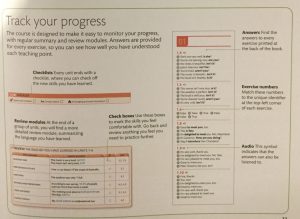
Checklists Every unit ends with a checklist, where you can check off the new skills you have learned.
Review modules At the end of a group of units, you will find a more detailed review module, summarizing the language you have learned.
Check boxes Use these boxes to mark the skills you feel comfortable with. Go back and review anything you feel you need to practice further.
Answers Find the answers to every exercise printed at the back of the book.
Exercise numbers Match these numbers to the unique identifier at the top-left corner of each exercise.
Audio This symbol indicates that the answers can also be listened to.
目次 – English for Everyone: Level 4: Advanced, Course Book: A Complete Self-Study Program
英語は英語で学ぶ
「English for Level」シリーズのレベル4です。中級者~上級者向けの内容になっています。TOEFL・TOEICなど主要の英語試験に必要な語彙や文法、演習がカバーされています。本書の文章は全て英語で書かれており、英語を英語で学ぶことによって新しい気づきを得られます。
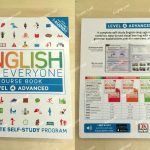
Author
Victoria Boobyer is a freelance writer, presenter, and teacher trainer with a background in English-language teaching and teacher management. She has a keen interest in the use of graded readers and the sound pedagogical use of technology in teachin.
Course consultant
Tim Bowen has taught English and trained teachers in more than 30 countries worldwide. He is the co-author of works on pronunciation teaching and language-teaching methodology, and author of numerous books for English-language teachers. He is currently a freelance materials writer, editor, and translator. He is a member of the Chartered Institute of Linguists.
Language consultant
Professor Susan Barduhn is an experienced English-language teacher, teacher trainer, and author, who has contributed to numerous publications. In addition to directing English-language courses in at least four different continents, she has been President of the International Association of Teachers of English as a Foreign Language, and an adviser to the British Council and the US State Department. She is currently a Professor at the School for International Training in Vermont, USA.
Penguin Random House
US Editors Allison Singer, Jenny Siklos
Editors Gareth Clark, Lisa Gillespie, Andrew Kerr-Jarrett
Art Editors Chrissy Barnard, Ray Bryant
Senior Art Editor Sharon Spencer
Editorial Assistants Jessica Cawthra, Sarah Edwards
Illustrators Edwood Burn, Denise Joos, Michael Parkin, Jemma Westing
Audio Producer Liz Hammond
Managing Editor Daniel Mills
Managing Art Editor Anna Hall
Project Manager Christine Stroyan
Jacket Designer Natalie Godwin
Jacket Editor Claire Gell
Jacket Design Development Manager Sophia MTT
Producer, Pre-Production Luca Frassinetti
Producer Mary Slater
Publisher Andrew Macintyre
Art Director Karen Self
Publishing Director Jonathan Metcalf
DK India
Jacket Designer Surabhi Wadhwa
Managing Jackets Editor Saloni Singh
Senior DTP Designer Harish Aggarwal
First American Edition, 2016 Published in the United States by DK Publishing 1450 Broadway, Suite 801, New York, NY 10018
Copyright © 2016 Dorling Kindersley Limited DK, a Division of Penguin Random House LLC 1920109876543 021-289759-Jun/2016
All rights reserved. Without limiting the rights under the copyright reserved above, no part of this publication may be reproduced, stored in or introduced into a retrieval system, or transmitted, in any form, or by any means (electronic, mechanical, photocopying, recording, or otherwise), without the prior written permission of the copyright owner. Published in Great Britain by Dorling Kindersley Limited.
A catalog record for this book is available from the Library of Congress. ISBN 978-1-4654-4835-4
DK books are available at special discounts when purchased in bulk for sales promotions, premiums, fund-raising, or educational use. For details, contact: DK Publishing Special Markets, 1450 Broadway, Suite 801, New York, NY 10018
Special Sales@dk.com
Printed and bound in China
All images © Dorling Kindersley Limited For further information see: www.dkimages.com
A WORLD OF IDEAS: SEE ALL THERE IS TO KNOW
www.dk.com
Contents
How the course works
01 Making conversation
New language Present tenses
Vocabulary Meeting new people
New skill Using question tags
02 Action and state verbs
New language State verbs in continuous forms
Vocabulary Action and state verbs
New skill Describing states
03 Using collocations
New language Collocations
Vocabulary Beliefs and opinions
New skill Talking about your life
04 Complex descriptions
New language General and specific adjectives
Vocabulary Personalities
New skill Ordering adjectives
05 Making general statements
New language Introductory “it”
Vocabulary Talents and abilities
New skill Expressing general truths
06 Vocabulary Travel and tourism
07 Phrasal verbs
New language Phrasal verbs overview
Vocabulary Travel
New skill Using complex phrasal verbs
08 Narrative tenses
New language The past perfect continuous
Vocabulary Travel adjectives and idioms
New skill Talking about a variety of past actions
09 Giving advice and opinions
New language Modals for advice and opinion
Vocabulary Recommendations
New skill Giving advice and opinions
10 Making predictions
New language Degrees of likelihood
Vocabulary Idioms about time
New skill Talking about possibilities
11 Vocabulary Family and relationships
12 Using discourse markers
New language Linking information
Vocabulary Family history
New skill Talking about relationships
13 Past habits and states
New language “Used to” and “would”
Vocabulary Family values
New skill Contrasting the past with the present
14 Comparing and contrasting
New language “As… as” comparisons
Vocabulary Adjective-noun collocations
New skill Comparing and contrasting
15 Two comparatives together
New language Two comparatives together
Vocabulary Age and population
New skill Expressing cause, effect, and change
16 Vocabulary Studying
17 Taking notes
New language Organizing information
Vocabulary Academic life
New skill Taking notes
18 Speaking approximately
New language Generalization
Vocabulary Approximate quantity phrases
New skill Talking about numbers
19 Changing emphasis
New language The passive voice
Vocabulary Online learning
New skill Changing sentence emphasis
20 Things that might happen
New language “What if” “suppose,” “in case”
Vocabulary Exams and assessment
New skill Talking about hypothetical situations
21 Vocabulary Working
22 Job applications
New language Prepositions and gerunds
Vocabulary Job applications
New skill Writing a résumé and cover letter
23 Asking polite questions
New language Direct and indirect questions
Vocabulary Job interviews
New skill Asking questions politely
24 Complex verb patterns
New language Verb + infintive / gerund
Vocabulary World of work
New skill Using complex verb patterns
25 Double object verbs
New language Double object verbs
Vocabulary New businesses
New skill Talking about starting a business
26 Vocabulary Meeting and presenting
27 Reflexive pronouns
New language Reflexive pronouns
Vocabulary Workplace language
New skill Talking about work issues
28 Meeting and planning
New language Combining verbs
Vocabulary Office tasks
New skill Taking part in meetings
29 Qualifying descriptions
New language Non-gradable adjectives
Vocabulary Qualifying words
New skill Adding detail to descriptions
30 Expressing purpose
New language “In order to,” “so that”
Vocabulary Language of apology
New skill Expressing purpose
31 Vocabulary Environmental concerns
32 Conditional tenses
New language The third conditional
Vocabulary Environmental threats
New skill Talking about an unreal past
33 Past regrets
New language Should have” and “ought to have
Vocabulary Time markers
New skill Expressing regret about the past
34 Actions and consequences
New language Dependent prepositions
Vocabulary Actions and consequences
New skill Changing sentence stress
35 Few or little?
New language “Few” “little,” “fewer,” “less”
Vocabulary Nature and environment
New skill Describing quantities
36 Vocabulary Tradition and superstition
37 Past possibility
New language “Might/may/ could” in the past
Vocabulary Urban myths
New skill Talking about past possibility
38 Speculation and deduction
New language More uses for modal verbs
Vocabulary Phrasal verbs with “out”
New skill Speculating and making deductions
39 Mixed conditionals
New language Mixed conditionals
Vocabulary Personality traits
New skill Talking about hypothetical situations
40 Adding “-ever” to question words
New language Words with “-ever”
Vocabulary Chance and weather phrases
New skill joining a clause to a sentence
41 Vocabulary Media and celebrity
42 Reporting with passives
New language Passive voice for reporting
Vocabulary Reporting language
New skill Distancing yourself from facts
43 Making indirect statements
New language Indirect statements
Vocabulary Hedging language
New skill Expressing uncertainty
44 Adding emphasis
New language Inversion after adverbials
Vocabulary Media and celebrity
New skill Adding emphasis to statements
45 Shifting focus
New language focusing with clauses
Vocabulary Phrases for emphasis
New skill Shifting focus
46 Vocabulary Crime and the law
47 Relative clauses
New language Relative clauses
Vocabulary Crime and criminals
New skill Specifying and elaborating
48 More relative clauses
New language Where, when, whereby, whose
Vocabulary Courtroom phrases
New skill Using relative words
49 Modal verbs in the future
New language “Will be able to.” “will have to”
Vocabulary Legal terms
New skill Expressing future ability and obligation
50 Modal verbs overview
New language Using modal verbs
Vocabulary Modal verbs
New skill Asking, offering, and predicting
51 Vocabulary Customs and cultures
52 Talking about groups
New language Using adjectives as nouns
Vocabulary Countries and nationalities
New skill Generalizing politely
53 Old and new situations
New language “Be used to” and “get used to”
Vocabulary Moving and living abroad
New skill Talking about old and new situations
54 Articles
New language Articles
Vocabulary Commonly misspelled words
New skill Saying words with silent letters
55 Abstract ideas
New language Concrete and abstract nouns
Vocabulary Education systems
New skill Talking about abstract ideas
56 Vocabulary Technology and the future
57 Future hopes
New language “Wish with “would” or “could”
Vocabulary Hopes for the future
New skill Talking about future hopes and wishes
58 The future continuous
New language The future continuous with “will”
Vocabulary Polite requests
New skill Planning your career
59 The future perfect
New language The future perfect
Vocabulary Life plans
New skill Making plans and predictions
60. The future in the past
New language “Would” and “was going to”
Vocabulary Changing plans
New skill Saving what you thought
61 Vocabulary Art and culture
62 Leaving words out
New language Ellipsis
Vocabulary Entertainment
New skill Leaving out unneccessary words
63 Substituting words
New language Substitution
Vocabulary Books and reading
New skill Replacing phrases
64 Shortening infinitives
New language Reduced infinitives
Vocabulary Music and performance
New skill Avoiding repetition
65 Expressing reactions
New language Informal discourse markers
Vocabulary Advanced prefixes
New skill Structuring conversation
66 Getting things done
New language “Have / get something done”
Vocabulary Services and repairs
New skill Describing things people do for you
67 Complex agreement
New language Complex agreement
Vocabulary Collective nouns
New skill Using the correct agreement
68 “So” and “such”
New language “So” and “such” for emphasis
Vocabulary Medical science
New skill Emphasizing descriptions
69 Using articles to generalize
New language Generic the
Vocabulary Exploration and invention
New skill Using advanced articles
Answers
Index
How the course works
English for Everyone is designed for people who want to teach themselves the English language. Like all language courses, it covers the core skills: grammar, vocabulary, pronunciation, listening, speaking, reading, and writing. Unlike in other courses, the skills are taught and practiced as visually as possible, using images and graphics to help you understand and remember. The best way to learn is to work through the book in order, making full use of the audio available on the website and app. Turn to the practice book at the end of each unit to reinforce your learning with additional exercises.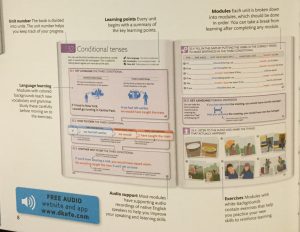
Unit number The book is divided into units. The unit number helps you keep track of your progress.
Learning points Every unit begins with a summary of the key learning points.
Modules Each unit is broken down into modules, which should be done in order. You can take a break from learning after completing any module.
Language learning Modules with colored backgrounds teach new vocabulary and grammar.
Study these carefully before moving on to the exercises.
Audio support Most modules have supporting audio recordings of native English speakers to help you improve your speaking and listening skills.
Exercises Modules with white backgrounds contain exercises that help you practice your new skills to reinforce learning.
FREE AUDIO
website and app
www.dkefe.com
Language modules
New language points are taught in carefully graded stages, starting with a simple explanation of when they are used, then offering further examples of common usage and a detailed breakdown of how key constructions are formed.
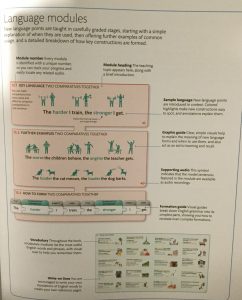
Module number Every module is identified with a unique number, so you can track your progress and easily locate any related audio.
Module heading The teaching topic appears here, along with a brief introduction.
Sample language New language points are introduced in context. Colored highlights make new constructions easy to spot, and annotations explain them.
Graphic guide Clear, simple visuals help to explain the meaning of new language forms and when to use them, and also act as an aid to learning and recall.
Supporting audio This symbol indicates that the model sentences featured in the module are available as audio recordings.
Formation guide Visual guides break down English grammar into its simplest parts, showing you how to recreate even complex formations.
Vocabulary Throughout the book, vocabulary modules list the most common and useful English words and phrases, with visual cues to help you remember them.
Write-on lines You are encouraged to write your own translations of English words to create your own reference pages.
Practice modules
Each exercise is carefully graded to drill and test the language taught in the corresponding course book units. Working through the exercises alongside the course book will help you remember what you have learned and become more fluent. Every exercise is introduced with a symbol to indicate which skill is being practiced.
GRAMMAR Apply new language rules in different contexts.
VOCABULARY Cement your understanding of key vocabulary.
SPEAKING Compare your spoken English to model audio recordings.
READING Examine target language in real-life English contexts.
LISTENING Test your understanding of spoken English
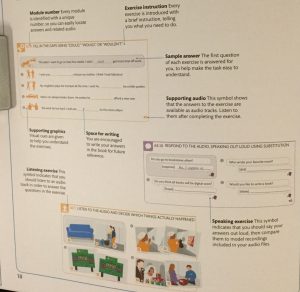
Module number Every module is identified with a unique number, so you can easily locate answers and related audio.
Exercise instruction Every exercise is introduced with a brief instruction, telling you what you need to do.
Sample answer the first question of each exercise is answered for you, to help make the task easy to understand.
Space for writing You are encouraged to write your answers in the book for future reference.
Supporting graphics Visual cues are given to help you understand the exercises.
Supporting audio This symbol shows that the answers to the exercise are available as audio tracks. Listen to them after completing the exercise.
Listening exercise This symbol indicates that you should listen to an audio track in order to answer the questions in the exercise.
Speaking exercise This symbol indicates that you should say your answers out loud, then compare them to model recordings included in your audio files.
Audio
English for Everyone features extensive supporting audio materials. You are encouraged to use them as much as you can, to improve your understanding of spoken English, and to make your own accent and pronunciation more natural. Each file can be played, paused, and repeated as often as you like, until you are confident you understand what has been said.
LISTENING EXERCISES This symbol indicates that you should listen to an audio track in order to answer the questions in the exercise.
SUPPORTING AUDIO This symbol indicates that extra audio material is available for you to listen to after completing the module.
FREE AUDIO website and app www.dkefe.com
Track your progress
The course is designed to make it easy to monitor your progress, with regular summary and review modules. Answers are provided for every exercise, so you can see how well you have understood each teaching point.
Checklists Every unit ends with a checklist, where you can check off the new skills you have learned.
Review modules At the end of a group of units, you will find a more detailed review module, summarizing the language you have learned.
Check boxes Use these boxes to mark the skills you feel comfortable with. Go back and review anything you feel you need to practice further.
Answers Find the answers to every exercise printed at the back of the book.
Exercise numbers Match these numbers to the unique identifier at the top-left corner of each exercise.
Audio This symbol indicates that the answers can also be listened to.



